| Author |
Message |
Martin Wallgren

|
|
    |
 |
Nathan Robinson
myArmoury Admin


|
 Posted: Fri 29 Jan, 2010 1:55 am Post subject: Posted: Fri 29 Jan, 2010 1:55 am Post subject: |
 |
|
Christian and Peter-
I really, really enjoy reading these types of topics and seeing in-progress shots that show us a bit of insight into what it is that you guys do.
Just wanted to say thanks for taking the time to do so this and by all means share as much of this kind of thing in the future as your time allows. A lot of us eat this stuff up.
.:. Visit my Collection Gallery :: View my Reading List :: View my Wish List :: See Pages I Like :: Find me on Facebook .:.
|
|
    |
 |
|
Peter Johnsson
Industry Professional
|
 Posted: Fri 29 Jan, 2010 2:20 am Post subject: Posted: Fri 29 Jan, 2010 2:20 am Post subject: |
 |
|
Weapons from a Swedish warrior grave (1st C AD or late 1st C BC?).
The single edged sword is of a kind that is narrow and long but pretty thick in section: a generous triangular shape with good apple seed edge geometry (Not too different from a good sized Wakisashi!)
The lance is not too spectacular, but the small javelin head! Note how neatly it is forged and fileworked.
 Attachment: 73.92 KB Attachment: 73.92 KB
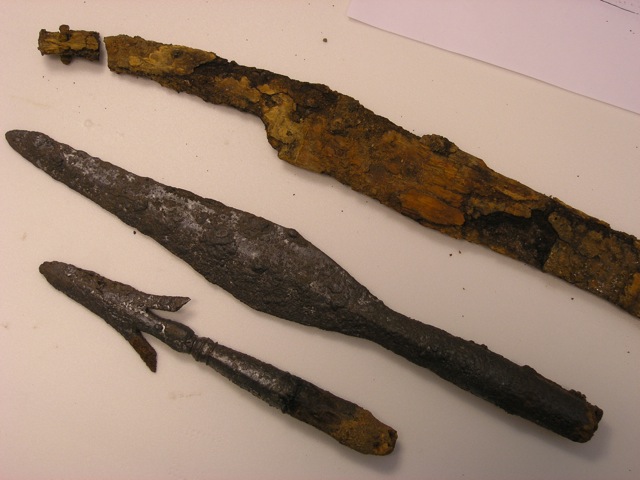
 Attachment: 64.1 KB Attachment: 64.1 KB

 Attachment: 74.88 KB Attachment: 74.88 KB
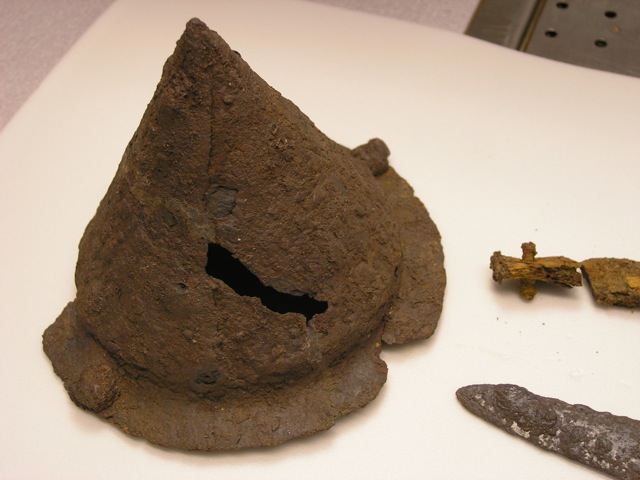
Conical shield boss. Someone who knows the typology and dating of these may help dating the find more exactly?
|
|
   |
 |
Shahril Dzulkifli

|
 Posted: Fri 29 Jan, 2010 4:10 am Post subject: Re: Germanic Iron Age Weapons Posted: Fri 29 Jan, 2010 4:10 am Post subject: Re: Germanic Iron Age Weapons |
 |
|

Christian,
I wonder if you can make Germanic spathas or long swords just like the one held by the Arminius statue near Detmold in North Rhine-Westphalia (photo).
“You have power over your mind - not outside events. Realize this, and you will find strength”
- Marcus Aurelius
|
|
  |
 |
|
Christian Böhling
Industry Professional
|
 Posted: Fri 29 Jan, 2010 5:16 am Post subject: Posted: Fri 29 Jan, 2010 5:16 am Post subject: |
 |
|
forge weld layer-welded sockets:
yes, while doing I also found out that starting the weld in a very early state of forming the socket makes a better closed seam, I also succeeded forging the whole socket-spread at once and closing it nearly, bringing it close before weld temperature while the small horn is heated. Than carefully I brought the socket flanks to welding heat (with weld-powder made of borax and steel-tinder - I don´t know the english word for it) and quickly closed the distal end over the hot horn, apply more welding-powder, bring it again to weld-heat and close the rest - shure I have to grind the last 5 mm off as it is not pretty.
The filed little javelin: we found a roman javelin with a small filed kind of bullet at our battlefield side and I know of some examples found at the burial-sites at the lower river Elbe in Germany with quite similair decorations - maybe a ritual thing or an insignia of rank, who knows...
So we can easyly prove that the germanic craftsmen often finished their products to an end of perfection, not like most poor tv-documentary want people believe.
And Peter, your trial is an interesting thing to me as I tried a similair thing myself last summer, after we finished our iron-furnace festival we owned a good bloom to make a bigger thing than the times before...
And yes, there are probably missing links enough beginning from the earliest find of single-edged swords from Hjørtspring 350 B.C. to those of the periode 1st C AD till 1st C BC, and next missing link until the seaxes appear. But probably it is human to always want a link between things as we strongly believe in a straight devellopement of all things...
There are some pics of a single-edged sword from Denmark I took at the Vendsyssel-Museum in Hjørring last October.
It is so sad, but they let it fall into pieces without restoring it, it has a good substance even with scabbard-remains....So sad!!!! I know we are also not able to immediately restore what we recently excavated, but most items are waiting for it in a special kind of fridgerator without any oxygen.... we have only one resttaurator but hundreds of roman finds each year.
But now for the images: If you want to have them in high resolution, I can send them to you in a PM. I wished I could take the sword to our X-ray laboratory, but the danes will hopefully do this soon themselves!
And to Shahril: Haha  Yes we can!!! Give us lots of copper-plates to make this 7 Meters long ;-) But serious: The Artist who made the figure (Ernst von Bandel) made it fictional, even when there were dozends of originals known between 1866 and 1875, when Bandel made the statue for the unfinished Monument. Yes we can!!! Give us lots of copper-plates to make this 7 Meters long ;-) But serious: The Artist who made the figure (Ernst von Bandel) made it fictional, even when there were dozends of originals known between 1866 and 1875, when Bandel made the statue for the unfinished Monument.
 Attachment: 99.71 KB Attachment: 99.71 KB
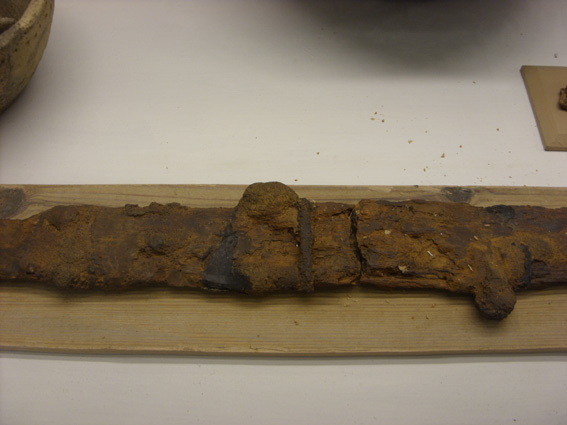
 Attachment: 104.08 KB Attachment: 104.08 KB
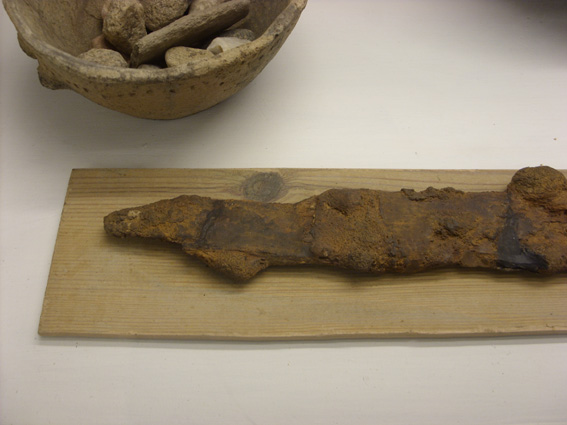
 Attachment: 104.52 KB Attachment: 104.52 KB

 Attachment: 147.01 KB Attachment: 147.01 KB
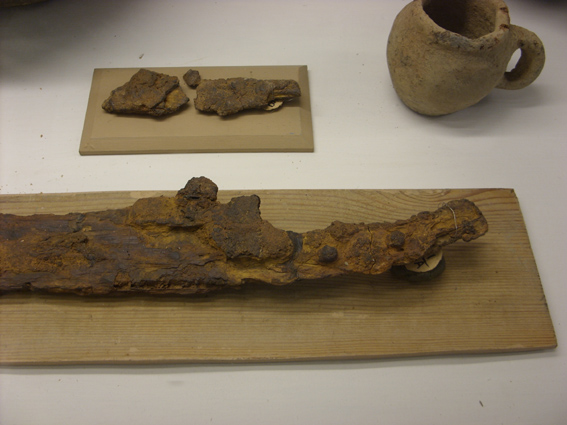
www.archaeoschmiede.de
www.eisenzeithaus.de
|
|
   |
 |
|
Christian Böhling
Industry Professional
|
|
   |
 |
|
Christian Böhling
Industry Professional
|
 Posted: Fri 29 Jan, 2010 6:00 am Post subject: Posted: Fri 29 Jan, 2010 6:00 am Post subject: |
 |
|
...just before I go, to not forget the in-progress-shots 
 Attachment: 113.19 KB Attachment: 113.19 KB

 Attachment: 108.02 KB Attachment: 108.02 KB

 Attachment: 110.12 KB Attachment: 110.12 KB

www.archaeoschmiede.de
www.eisenzeithaus.de
|
|
   |
 |
|
Russ Ellis
Industry Professional
|
 Posted: Fri 29 Jan, 2010 6:41 am Post subject: Posted: Fri 29 Jan, 2010 6:41 am Post subject: |
 |
|
A fascinating thread gentlemen, I only wish I had something useful to contribute to the discussion, I've been considering purchasing a copy of British Iron Age Swords and Scabbards and you all may just have put me over the tipping point with this thread. There are so many areas of archaelogy and weapons history and so little time to study them. One day I'm looking at Saxon finds from York the next reading a book about Catherine de Medici in Rennaisance France, my copy of the book about the Staffordshire Hoard just arrived in the mail and now I find myself fascinated by these early Germanic weapons.  Thanks! Thanks!
TRITONWORKS Custom Scabbards
|
|
  |
 |
Paul Hansen

|
 Posted: Sun 31 Jan, 2010 3:28 am Post subject: Posted: Sun 31 Jan, 2010 3:28 am Post subject: |
 |
|
This is a very interesting thread on some very interesting and until recently much overlooked weapons.
To me personally, I find this hilt configuration, which is a bit falcata-like, very interesting. But I have to say that it does seem to be a slightly wasteful use of valuable iron...
Does anyone happen to have some pictures of originals? I'm very interested to the thickness of this enclosed hilt.
|
|
  |
 |
|
Peter Johnsson
Industry Professional
|
 Posted: Sun 31 Jan, 2010 8:16 am Post subject: Posted: Sun 31 Jan, 2010 8:16 am Post subject: |
 |
|
I have photos of originals (Among these is the one I based the Albion "Cherusker" on). But you cannot really see the thickness of the material in those photos of originals. You can see this in the detail shots of the Cherusker, however.
Mostly the thickness is not very great. The section of the material in the grip is often a continuation f the cross section of the blade: a wedge that is thinner towards the edge side of the blade. Along the thickness back it can be around 4.5 -5.5 millimeters. Narrower bladed examples tend to be thicker in the back.
Generally these single edged swords are not very heavy. There is an early type that has a tang that is only a straight flat rod with holes for many rivets. There swords are pretty big and broad, but are still not very thick in the back. Sometimes you see a slight T-back formed along the back of the blade.
 Attachment: 72.27 KB Attachment: 72.27 KB
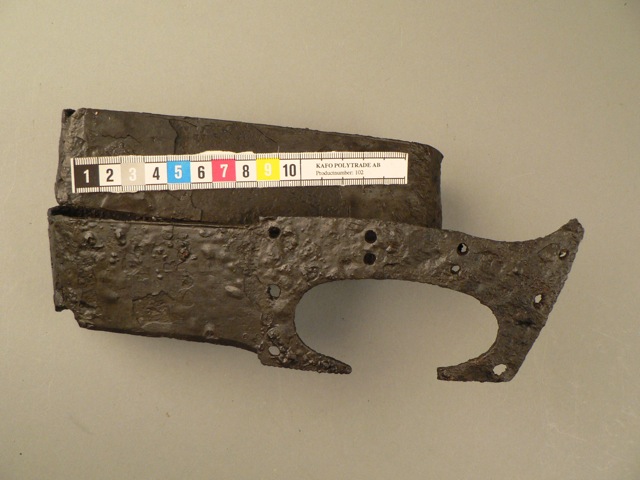
 Attachment: 68.56 KB Attachment: 68.56 KB
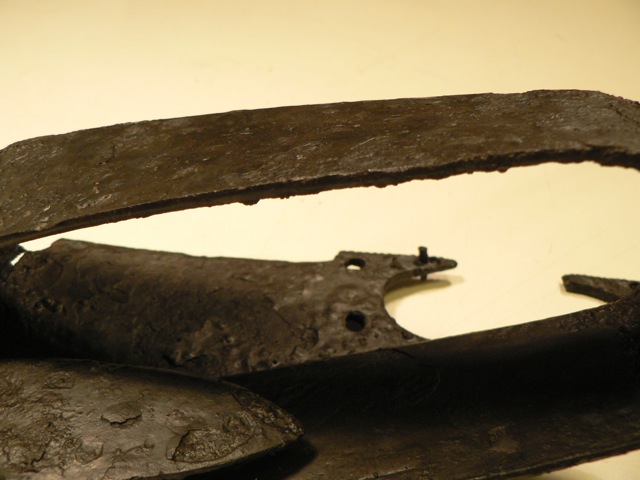
 Attachment: 26.31 KB Attachment: 26.31 KB
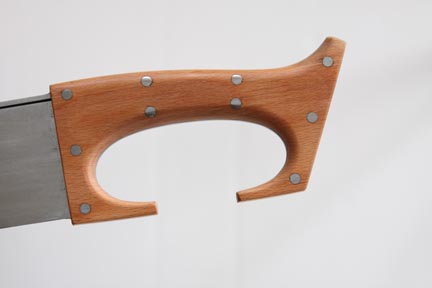
 Attachment: 23.09 KB Attachment: 23.09 KB

|
|
   |
 |
|
Jeroen Zuiderwijk
Industry Professional
|
|
   |
 |
|
Tim Lison
|
 Posted: Sun 31 Jan, 2010 10:39 am Post subject: Posted: Sun 31 Jan, 2010 10:39 am Post subject: |
 |
|
|
Great thread! I am curious about the rather distinctive scabbards that these swords have. It seems that they are made from wooden slats...is this true? It seems odd to me but I just don't know enough about it to be sure.
|
|
  |
 |
|
Christian Böhling
Industry Professional
|
 Posted: Sun 31 Jan, 2010 10:58 am Post subject: Posted: Sun 31 Jan, 2010 10:58 am Post subject: |
 |
|
Peter, wonderful cross-section in the grip-part!
The Putensen Sword original is lost, only a photography and a drawing and of course the description by W. Wegewitz remained from the find because it is an old find. But the Åsby and the Putensen ones are so similair, that one can suggest the same maker...and if I complete this thoughts I can imagine, that the Putensen one had the same cross-section in the grip-part. I had no idea of this detail!! Next time I will do it this way!
The Putensen was in total 69 cm long (about 27 inches), I made the blade back right at the heft 5 mm thick, slowely narrowing towards the tip....
here are some new work-in-progress shots (sorry for the bad quality, have to do some pics tomorrow together with the brass fittings and the broad brass bar-like finish at the lower end of the scabbard. W. Wegewitz (who belabored the finds from the funeral burial-site at the lower Elbe in the late 1920s) discribed a wooden scabbard like the one I did here with a horizontal end and a bronze bar at the end...
I think tomorrow I will finishing it all and make final pics!
What do you say?
BTW: Peter, please let us think about the strange brass fittings which sometimes have remained at the grips of these swords (I don´t mean the decorated rivets)
The last pic shows a recently found sword from Woer in Netherlands. Jeroen 
 Attachment: 95.14 KB Attachment: 95.14 KB

 Attachment: 101.15 KB Attachment: 101.15 KB
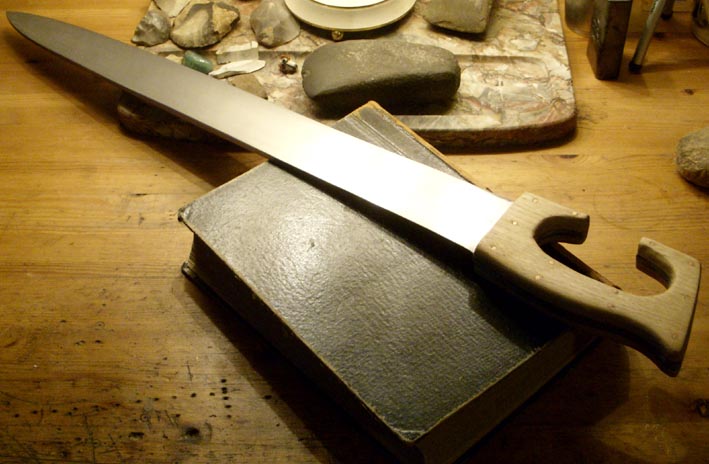
 Attachment: 102.45 KB Attachment: 102.45 KB

 Attachment: 103.28 KB Attachment: 103.28 KB
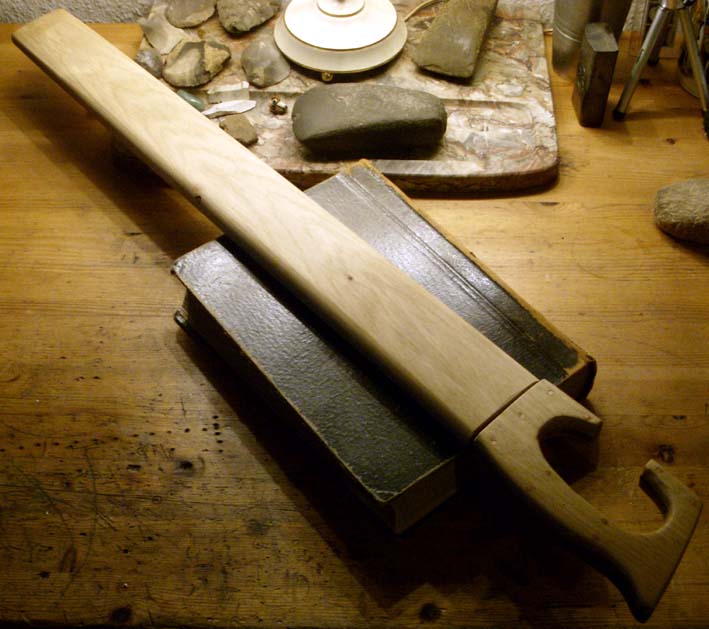
 Attachment: 106.98 KB Attachment: 106.98 KB
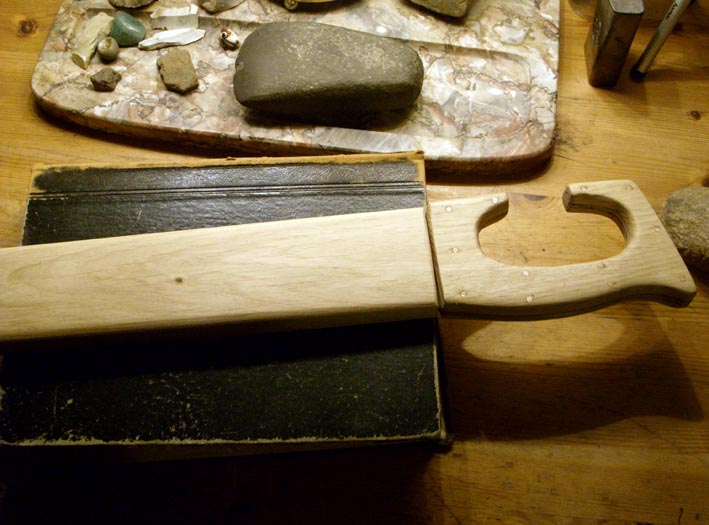
 Attachment: 91.76 KB Attachment: 91.76 KB
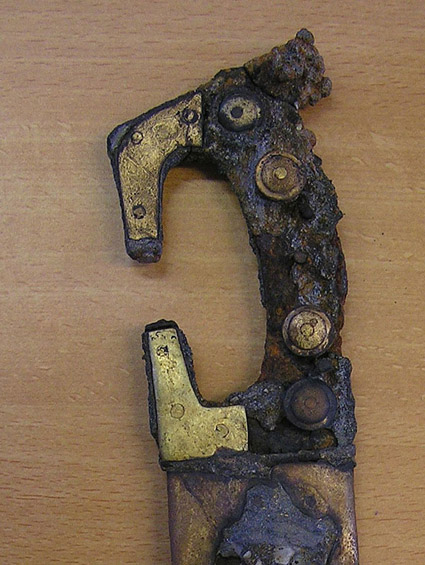
www.archaeoschmiede.de
www.eisenzeithaus.de
Last edited by Christian Böhling on Sun 31 Jan, 2010 11:54 am; edited 2 times in total
|
|
   |
 |
|
Christian Böhling
Industry Professional
|
 Posted: Sun 31 Jan, 2010 11:01 am Post subject: Posted: Sun 31 Jan, 2010 11:01 am Post subject: |
 |
|
Yes, Tim, the scabbards were wooden, I wonder, why my pics dont show, that this scabbard is getting narrower to its end...hmm, maybe a question of the perspective I used....
The sword from Woer shows, that its wooden grip must have been very thin, as there is not much space between the rivet-plates and the sword....
BTW: This might be the first worldwide public discussion of these swords!!!!
www.archaeoschmiede.de
www.eisenzeithaus.de
|
|
   |
 |
|
Christian Böhling
Industry Professional
|
 Posted: Sun 31 Jan, 2010 11:28 am Post subject: Posted: Sun 31 Jan, 2010 11:28 am Post subject: |
 |
|
This is another sword of this type I made about 10 Years ago....it was cruelful cleaned from the corrosion of 10 years use in reenactments.....but its sweet, it has a wooden scabbard with eight tinned brass straps around and a bar ending.
 Attachment: 93.97 KB Attachment: 93.97 KB
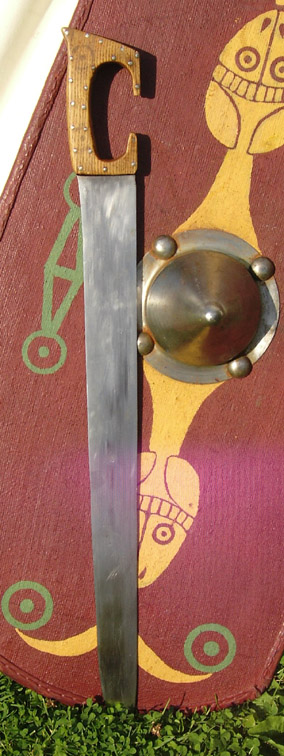
www.archaeoschmiede.de
www.eisenzeithaus.de
|
|
   |
 |
|
Christian Böhling
Industry Professional
|
 Posted: Sun 31 Jan, 2010 11:40 am Post subject: Posted: Sun 31 Jan, 2010 11:40 am Post subject: |
 |
|
Here are some impressions of a long-sword found in Nienbüttel at the Elbe river. The original metal parts are stored in Hanover-Museum and I had the priveledge to study them. The wooden grip has not remained (it´s my interpretation). But all metal parts are shown exact ....I made it about 10 years ago...
I show this, not to make people who are not that familair with the Germanics beleive that Germanics used only single-edged swords 
 Attachment: 100.62 KB Attachment: 100.62 KB
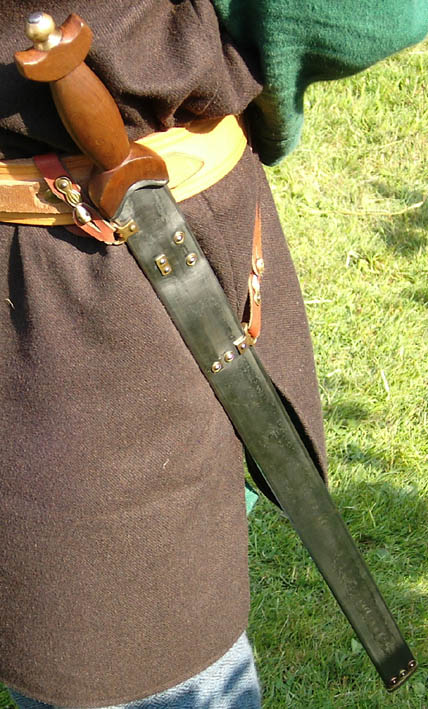
note the bar-like end-fitting at the scabbard an often typical detail
 Attachment: 98.58 KB Attachment: 98.58 KB
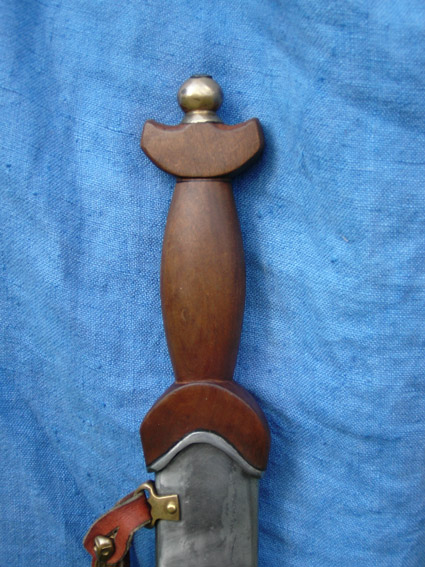
 Attachment: 101.04 KB Attachment: 101.04 KB
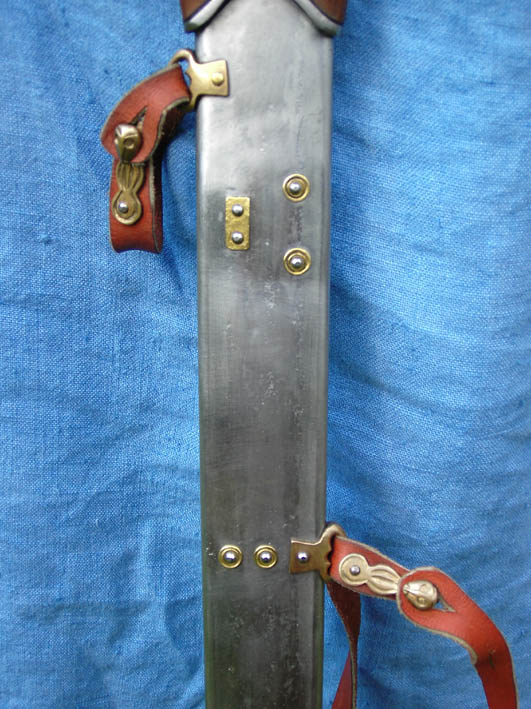
www.archaeoschmiede.de
www.eisenzeithaus.de
|
|
   |
 |
|
Christian Böhling
Industry Professional
|
 Posted: Sun 31 Jan, 2010 11:49 am Post subject: Posted: Sun 31 Jan, 2010 11:49 am Post subject: |
 |
|
| Paul Hansen wrote: | This is a very interesting thread on some very interesting and until recently much overlooked weapons.
To me personally, I find this hilt configuration, which is a bit falcata-like, very interesting. But I have to say that it does seem to be a slightly wasteful use of valuable iron...
Does anyone happen to have some pictures of originals? I'm very interested to the thickness of this enclosed hilt. |
Peter Johnsson surveyed a sword with a cut-out grip, but he is right, there is no waste of material since this cut out rest could easily re-forged ore used in a new forge-welding.
I supposed a forged grip (see at the beginning of this thread, page 1) and so my reconstruction has a grip forged out of the whole material...
To the thickness: have a look at the image of the Woerd-sword, I don´t know but it seems that the brass details allow to reconstruct the wooden grip in this case very thin....
The finds of this type of sword are spread from the Netherlands over Germany, Sweden eastwards to Russia....over the whole so-called Germania libera
 Attachment: 91.76 KB Attachment: 91.76 KB

www.archaeoschmiede.de
www.eisenzeithaus.de
|
|
   |
 |
Dan Dickinson
Industry Professional

|
|
  |
 |
|
Christian Böhling
Industry Professional
|
 Posted: Sun 31 Jan, 2010 12:04 pm Post subject: Posted: Sun 31 Jan, 2010 12:04 pm Post subject: |
 |
|
| Dan Dickinson wrote: | Christian, isn't that last original you posted (the one from Woer in the Netherlands) the same one that recently sparked a discussion if a "Roman Falcata" had been found?
Thanks,
Dan |
Hi Dan! I don´t know....I am new in this forum and I have not had the time yet to search the other threads here.....but if: It is defenitely no Falcata, even if some people sometimes compare it to the least. It is a typical germanic weapon...
www.archaeoschmiede.de
www.eisenzeithaus.de
|
|
   |
 |
|
Peter Johnsson
Industry Professional
|
 Posted: Mon 01 Feb, 2010 12:54 am Post subject: Posted: Mon 01 Feb, 2010 12:54 am Post subject: |
 |
|
The Woerden sword!
Yes that is a nice one. I was at the conference i Xanten when this sword was presented at the ROMEC conference. The suggestions as to origin and dating were quite all over the map. I was one of those suggesting germanic origin and a dating @ late 1st C BC or early 1st C AD. It seems that even among archaeologists with an interest for military equipment, these weapons are fairly unknown.
The hilt and scabbard of the Woerden sword is not exactly like anything else I´ve seen. Some differencers stand out: There is a scabbard slide and a mouth piece, as well as those striking rivet washer in the grip. Normally there is only D-sectioned iron bands wrapped around the wood scabbard, with one carrying ring at the top towards the edge side and another band some 15 or 20 cm down with a ring facing towards the back.
I would be very interested in learning about other swords of this type with similar scabbard and mounting. The Woerden sword strikes me as a high quality weapon with a local version of embellishment (with influences of roman cutlery traditions?). The scabbard belt slide (if it is a scabbard slide?) does hint at a pretty late date (2nd C AD?). I have asked those who work with the sword about the material remaining n the grip panels, but have so far not learned what it is. I am curious to know if it is wood, or as I suspect it might be: horn or antler.
The wrap around form (the two spurs) of these hilts may have been found on single edged swords that does not have the full tang like the Woerden, Åsby, Putesen and the one Jeroen posted above. The full tang weapons form a clear group within the family of single edged swords. Påvel Nicklasson in his thesis "Svärdet ljuger inte" (the sword does not lie) puts a date on this type to the decades around the year 1. I am not aware how this varies in areas away from Sweden/Scandinavia.
We can get tantalizing hints as to the shape for the grip parts on those swords that does not have this full tang or any organic parts remaining. In reconstructions it is common to see grip slabs that closely follow the shape of the rather small tags. I don´t think that is how they were shaped. I think the tang on those swords only followed part of the grip shape. I base this idea on some swords that have metal reinforcement remaining that show how the organic matter of the grip actually went outside the shape of the tang in some parts of the grip.
I also suspect that the metal mounts as seen on the Woerden sword are a "heritage" from a time when there were no metal supporting these spurs on the hilt. There is a Danish one: Åby Gammelgård, where I think the spurs of the hilt are unsuported by a full tang. Instead it has rather extensive surface reinforcing of iron (bronze?) straps, very much like the Woern sword, but even also a butt plate and one band going over the front end of the hilt towards the blade.
A somewhat similar thing can be seen on a Swedish find that has a very substantial reinforcement at the front of the hilt (perhaps there was a similar reinforcement at the heel of the hilt, but that has been lost/eaten away?) this find shows us clearly what the organic parts may have looked like. The back of the grip extended beyond the width of the tang, so that there was some 4 or 5 millimeter broader, meeting the back edge of the scabbard when the weapon was sheathed. On this find there is not the full tang shape of the Woerden/Åsby.
I attach some images below.
 Attachment: 31.38 KB Attachment: 31.38 KB
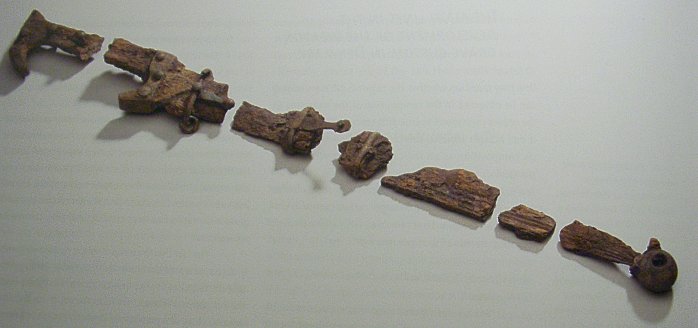
The sword from Åby Gammelgård. It is narrower than the ones shown earlier in the thread with full tang. I think the tang on this weapon is only part of the full form of the grip.
 Attachment: 84.22 KB Attachment: 84.22 KB
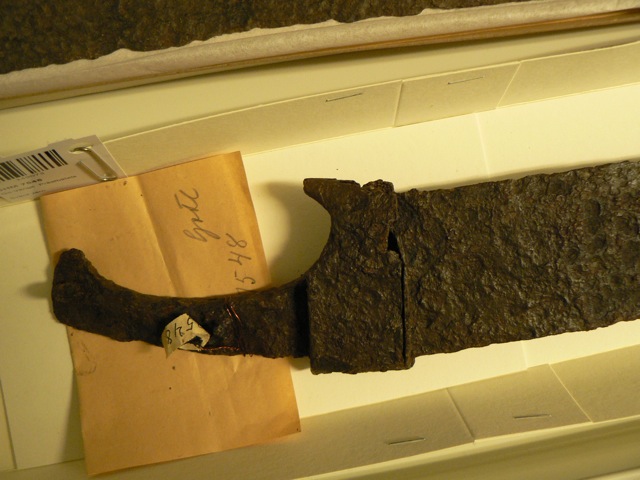
This blade does not have a full tang form, but the mount shows it had a spur at front end of the grip.
 Attachment: 64.37 KB Attachment: 64.37 KB
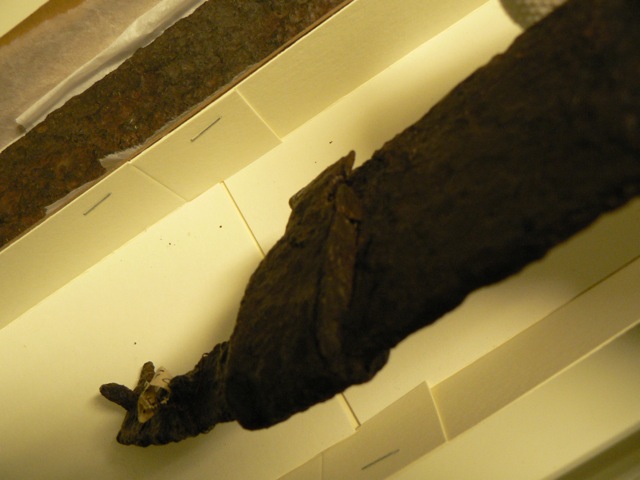
Note the front plate and how this defines the dimension of the organic parts beneath.
 Attachment: 66.48 KB Attachment: 66.48 KB
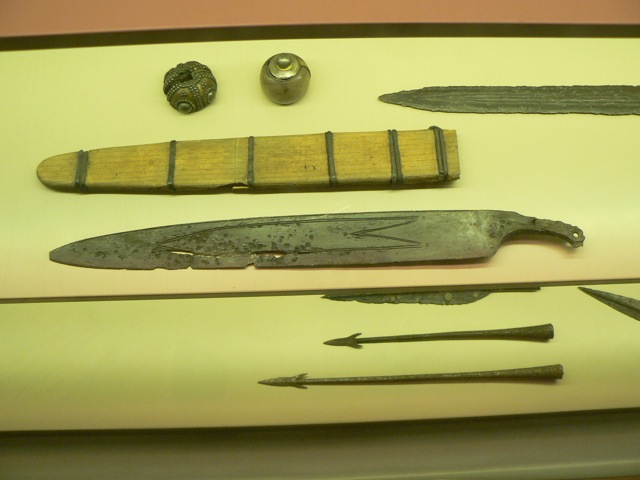
A Daninsh find. It is the same balde type as the one posted above: no full tang supporting spurs, but there may very well have been spurs of organic material!
 Attachment: 82.08 KB Attachment: 82.08 KB
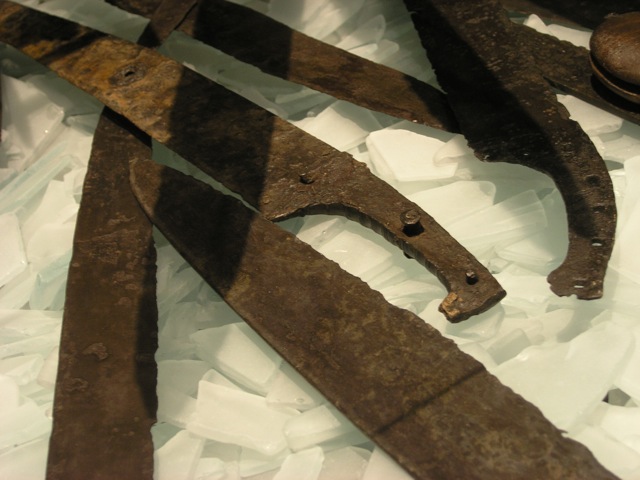
Both the tangs visible: the incomplete shape of the grip is hinted by the shape of the tang. It is easy to complete the shape with the minds eye, so that there are spurs at both ends of the grip.
|
|
   |
 |
|
|

